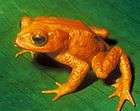Living fossil
A living fossil is a living species (or clade) of organism that closely resembles species otherwise known only from the fossil record. Normally, to be considered a living fossil, the fossil species must be old, relative to the age of the (living) clade. In several cases, living fossils are species-poor lineages, but this is not always the case. The term is not formally defined, but is commonly used in the scientific literature to mean a group characterized by an exceptionally low rate of evolution. The more technical term for such groups is "bradytelic".[1] The term living fossil is sometimes used in the popular literature, as if to imply a lack of evolution, and has occasionally also been taken to imply very low rates of molecular evolution, but scientific investigations have repeatedly discredited claims that these species do not change at all, as well as other misconceptions about living fossils.[2][3][4][5]
Overview
Living fossils have three main characteristics: (1) they exhibit notable longevity; (2) they demonstrate little morphological divergence from early members of the lineage as well as low morphological diversity within the group and (3) they often also exhibit little taxonomic diversity.[6]
Living fossils are not equivalent to a "Lazarus taxon", which is a taxon (either one species or a group of species) that suddenly reappears, either in the fossil record or in nature (i.e., as if the fossil had "come to life again"). In contrast, a living fossil is a species or lineage that has undergone exceptionally little change over a long time (i.e., as if the fossil species has always lived). The average species turnover time (the time a species lasts before it is replaced) varies widely among the phyla, but averages about 2–3 million years. So, a living species that was thought to be extinct (e.g., the coelacanth, Latimeria chalumnae) could be called a Lazarus taxon. It would also be considered a living fossil if it closely resembles the earliest members of its lineage. Coelacanths disappeared from the fossil record some 80 million years ago (upper Cretaceous) and if it does exhibit exceptionally low evolutionary rates, then it would qualify as both a Lazarus taxon and as a living fossil.
Some living fossils are taxa that were known from fossils before living representatives were discovered. The most famous examples of this are the coelacanthiform fishes Latimeria chalumnae and Latimeria menadoensis and the dawn redwood, Metasequoia, discovered in a remote Chinese valley. Others include glypheoid lobsters, mymarommatid wasps, eomeropid scorpionflies, and jurodid beetles, all of which were first described from fossils, but later found alive (2 species, 10 species, one species, and one species respectively). Others are a single living species that has no close living relatives, but is the survivor of a large and widespread group in the fossil record. Perhaps the best-known example is Ginkgo biloba, though there are others, such as Syntexis libocedrii (the cedar wood wasp). Dinoflagellates include also such examples, which have been first described as fossil-taxa (being typified on coccoid, occasionally calcareous cell remnants: dinocysts), but stratigraphically range until today.[7][8][9]
Just because a living fossil is a surviving representative of an archaic lineage does not necessarily require that it retains all of the "primitive" features (plesiomorphies) of the lineage it is descended from. Although it is common to say that living fossils exhibit "morphological stasis", they are not strictly identical to their ancestors. Some living fossils are relicts of formerly diverse and morphologically varied lineages, but survivors of ancient lineages are not necessarily living fossils. See for example the uniquely and highly autapomorphic oxpeckers, which appear to be the only survivors of an ancient lineage related to starlings and mockingbirds.[10]
Evolution and living fossils
The term living fossil is usually reserved for species or larger clades that are exceptional for their lack of morphological diversity and their exceptional conservatism, and several hypotheses could explain morphological stasis on a geologically long time-scale. Early analyses of evolutionary rates emphasized the persistence of a taxon rather than rates of evolutionary change.[11] Contemporary studies instead analyze rates and modes of phenotypic evolution, but most have focused on clades that are thought to be adaptive radiations rather than on those thought to be living fossils. Thus, very little is presently known about the evolutionary mechanisms that produce living fossils or how common they might be. Some recent studies have documented exceptionally low rates of ecological and phenotypic evolution despite rapid speciation.[12] This has been termed a "non-adaptive radiation" referring to diversification not accompanied by adaptation into various significantly different niches.[13] Such radiations are explanation for groups that are morphologically conservative. Persistent adaptation within an adaptive zone is a common explanation for morphological stasis.[14] The subject of very low evolutionary rates, however, has received much less attention in the recent literature than that of high rates
Living fossils are not expected to exhibit exceptionally low rates of molecular evolution, and some studies have shown that they do not.[15] For example, on tadpole shrimp (Triops), one article notes, "Our work shows that organisms with conservative body plans are constantly radiating, and presumably, adapting to novel conditions.... I would favor retiring the term ‘living fossil’ altogether, as it is generally misleading."[16]
The question posed by several recent studies pointed out that the morphological conservatism of coelacanths is not supported by paleontological data.[17][18] In addition, it was shown recently that studies concluding that a slow rate of molecular evolution is linked to morphological conservatism in coelacanths are biased by the a priori hypothesis that these species are ‘living fossils’.[19] Accordingly, the genome stasis hypothesis is challenged by the recent finding that the genome of the two extant coelacanth species L. chalumnae and L. menadoensis contain multiple species-specific insertions, indicating transposable element recent activity and contribution to post-speciation genome divergence.[20] Such studies, however, challenge only a genome stasis hypothesis, not the hypothesis of exceptionally low rates of phenotypic evolution.
History
The term was coined by Charles Darwin in his On the Origin of Species from 1859, when discussing Ornithorhynchus (the platypus) and Lepidosiren (the South American lungfish):
... All fresh-water basins, taken together, make a small area compared with that of the sea or of the land; and, consequently, the competition between fresh-water productions will have been less severe than elsewhere; new forms will have been more slowly formed, and old forms more slowly exterminated. And it is in fresh water that we find seven genera of Ganoid fishes, remnants of a once preponderant order: and in fresh water we find some of the most anomalous forms now known in the world, as the Ornithorhynchus and Lepidosiren, which, like fossils, connect to a certain extent orders now widely separated in the natural scale. These anomalous forms may almost be called living fossils; they have endured to the present day, from having inhabited a confined area, and from having thus been exposed to less severe competition.[21]
Other definitions
Long-enduring
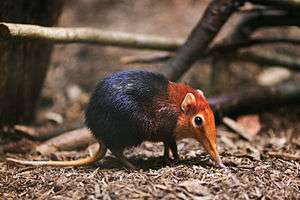
A living taxon that lived through a large portion of geologic time.
Queensland lungfish (Neoceratodus fosteri) is an example of an organism that meets this criterion, fossils identical to modern Queensland lungfish have been dated at over 100 million years making this species one of the oldest if not actually the oldest extant vertebrate species.
Resembles ancient species
A living taxon morphologically and/or physiologically resembling a fossil species through a large portion of geologic time (morphological stasis).[22]
The living specimens need not belong to the same fossil species (or even genus). There must at least be some physiological resemblance.
The coelacanth for example, is a marine fish. The Mesozoic coelacanth species lived in salt and fresh water. Osmoregulation in Latimeria is handled by urea retention. Urea retention is considered to indicate fresh water ancestry. This means that the coelacanth lineage evolved from freshwater to saltwater.
The resemblance between Peripatus and Aysheaia (an early Cambrian animal from the Burgess Shale) would be striking (both are classified in the Tardipolypoda, Tardigrada, and Onychophora), were it not that Aysheaia was a marine animal, while Peripatus lives in tropical leaf mould.
Retains many ancient traits
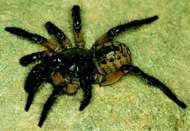
A living taxon with many characteristics believed to be primitive.
This is a more neutral definition. However, it does not make it clear whether the taxon is truly old, or it simply has many plesiomorphies. Note that, as mentioned above, the converse may hold for true living fossil taxa; that is, they may possess a great many derived features (autapomorphies), and not be particularly "primitive" in appearance.
Relict population
Any one of the above three definitions, but also with a relict distribution in refuges.
Some paleontologists believe that living fossils with large distributions (such as Triops cancriformis) are not real living fossils. In the case of Triops cancriformis (living from the Triassic until now), the Triassic specimens lost most of their appendages (mostly only carapaces remain), and they have not been thoroughly examined since 1938.
Low diversity
Any of the first three definitions, but the clade also has a low taxonomic diversity (low diversity lineages).
Oxpeckers are morphologically somewhat similar to starlings due to shared plesiomorphies, but are uniquely adapted to feed on parasites and blood of large land mammals, which has always obscured their relationships. This lineage forms part of a radiation that includes Sturnidae and Mimidae, but appears to be the most ancient of these groups. Biogeography strongly suggests that oxpeckers originated in eastern Asia and only later arrived in Africa, where they now have a relict distribution.[10]
The two living species thus seem to represent an entirely extinct and (as Passerida go) rather ancient lineage, as certainly as this can be said in the absence of actual fossils. The latter is probably due to the fact that the oxpecker lineage never occurred in areas where conditions were good for fossilization of small bird bones, but of course, fossils of ancestral oxpeckers may one day turn up enabling this theory to be tested.
Examples
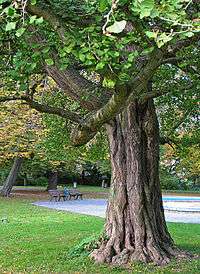
Some of these are informally known as "living fossils".
Bacteria
- Stromatolite, a layered structure created as sediment is trapped by shallow-water, oxygen-creating, blue-green bacteria
Protists
- The dinoflagellate †Calciodinellum operosum.[7]
- The dinoflagellate †Dapsilidinium pastielsii.[9]
- The dinoflagellate †Posoniella tricarinelloides.[8]
- The coccolithophore Tergestiella adriatica.[23]
Plants
- Pteridophytes
- Horsetails – Equisetum
- Lycopodiums
- Tree ferns
- Moss
- Gymnosperms
- Agathis - Agathis in Australia and the Pacific including Almasiga trees in the Philippines
- Araucaria araucana – the monkey puzzle tree (as well as other extant Araucaria species)
- Cycads
- Ginkgo tree (Ginkgoaceae)
- Metasequoia – dawn redwood (Cupressaceae; related to Sequoia and Sequoiadendron)
- Sciadopitys "Japanese umbrella pine"
- Taiwania cryptomerioides – one of the largest tree species in Asia.
- Wollemia tree (Araucariaceae – a borderline example, related to Agathis and Araucaria)[24][25]
- Welwitschia
- Angiosperms
- Amborella – a plant from New Caledonia, possibly closest to base of the flowering plants
- Trapa - water caltrops, seeds, and leaves of numerous extinct species are known all the way back to the Cretaceous.
- Nelumbo - several species of lotus flower are known exclusively from fossils dating back to the Cretaceous.
Fungi
Animals
- Vertebrates
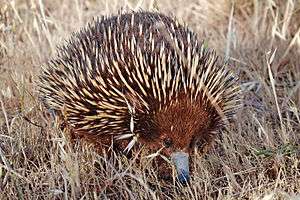 Echidnas are one of few mammals to lay eggs.
Echidnas are one of few mammals to lay eggs.
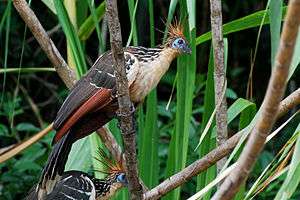
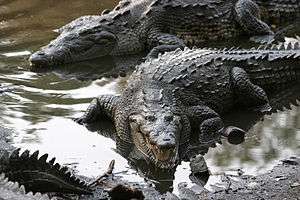
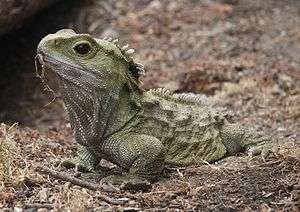
- Mammals
- Aardvark (Orycteropus afer)
- Amami rabbit (Pentalagus furnessi)[26]
- Chevrotain (Tragulidae)
- Elephant shrew (Macroscelidea)
- Laotian rock rat (Laonastes aenigmamus)
- Monito del monte (Dromiciops gliroides)
- Monotremes (the platypus and echidna)
- Mountain beaver (Aplodontia rufa)
- Okapi (Okapia johnstoni)[27]
- Opossums (Didelphidae)
- Capybara (Hydrochoerus hydrochaeris)
- Red panda (Ailurus fulgens)
- Solenodon (Solenodon cubanus and Solenodon paradoxus)
- Shrew opossum (Caenolestidae)
- False killer whale (Pseudorca crassidens)
- Pygmy right whale (Caperea marginata)[28][29]
- Birds
- Pelicans have been virtually unchanged since the Eocene, and are noted to have been even more conservative across the Cenozoic than crocodiles[30]
- Acanthisittidae (New Zealand "wrens") – 2 living species, a few more recently extinct. Distinct lineage of Passeriformes.
- Broad-billed sapayoa (Sapayoa aenigma) – One living species. Distinct lineage of Tyranni.
- Bearded reedling (Panurus biarmicus) – One living species. Distinct lineage of Passerida or Sylvioidea.
- Coliiformes (mousebirds) – 6 living species in 2 genera. Distinct lineage of Neoaves.
- Hoatzin (Ophisthocomus hoazin) – One living species. Distinct lineage of Neoaves.
- Magpie goose (Anseranas semipalmata) – One living species. Distinct lineage of Anseriformes.
- Seriema (Cariamidae) – 2 living species. Distinct lineage Cariamae.
- Tinamiformes (tinamous) 50 living species Distinct Lineage Palaeognathae
- Reptiles
- Alligator snapping turtle (Macrochelys temminckii)
- Crocodilia (crocodiles, gavials, caimans and alligators)
- Pig-nosed turtle (Carettochelys insculpta)
- Snapping turtle (Chelydra serpentina)
- Tuatara (Sphenodon punctatus and Sphenodon guntheri)
- Amphibians
- Giant salamanders (Cryptobranchus and Andrias)
- Hula painted frog (Latonia nigriventer)[31]
- Purple frog (Nasikabatrachus sahyadrensis)
- Jawless fish
- Hagfish (Myxinidae) Family
- Bony fish
- Arowana and arapaima (Osteoglossidae)
- Bowfin (Amia calva)
- Coelacanth (the lobed-finned Latimeria menadoensis and Latimeria chalumnae)
- Gar (Lepisosteidae)
- Queensland lungfish (Neoceratodus fosteri)
- Sturgeons and paddlefish (Acipenseriformes)
- Bichir (Polypteridae) family
- Protanguilla palau
- Mudskipper (Oxudercinae)
- Sharks
- Blind shark (Brachaelurus waddi)
- Bullhead shark (Heterodontus sp.)
- Elephant shark (Callorhinchus milii)
- Frilled shark (Chlamydoselachus sp.)
- Goblin shark (Mitsukurina owstoni)
- Gulper shark (Centrophorus sp.)
- Invertebrates
 Nautilus retain the external, spiral shell that its other relatives have lost.
Nautilus retain the external, spiral shell that its other relatives have lost.
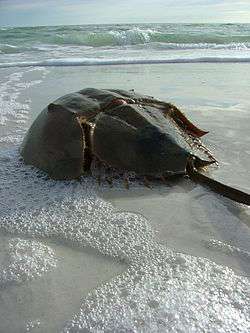
- Insects
- Mantophasmatodea (gladiators; a few living species)
- Meropeidae (3 living species, 4 extinct)
- Micromalthus debilis (a beetle)
- Mymarommatid wasps (10 living species in genus Palaeomymar)
- Nevrorthidae (3 species-poor genera)
- Nothomyrmecia (known as the dinosaur ant)
- Notiothauma reedi (a scorpionfly relative)
- Orussidae (parasitic wood wasps; about 70 living species in 16 genera)
- Peloridiidae (peloridiid bugs; fewer than 30 living species in 13 genera)
- Sikhotealinia zhiltzovae (a jurodid beetle)
- Syntexis libocedrii (Anaxyelidae cedar wood wasp)
- Crustaceans
- Glypheoidea (2 living species: Neoglyphea inopinata and Laurentaeglyphea neocaledonica)
- Stomatopods (mantis shrimp)
- Triops cancriformis (also known as tadpole shrimp; a notostracan crustacean)
- Molluscs
- Other invertebrates
- Crinoids
- Horseshoe crabs (only 4 living species of the class Xiphosura, family Limulidae: Limulus polyphemus,Tachypleus gigas, Tachypleus tridentatus and Carcinoscorpius rotundicauda)
- Lingula anatina (an inarticulate brachiopod)
- Liphistiidae (trapdoor spiders)
- Onychophorans (velvet worms)
- Valdiviathyris quenstedti (a craniforman brachiopod)
- Paleodictyon nodosum (unknown)
See also
References
- ↑ Simpson, George (1944). Tempo and Mode in Evolution. NY: Columbia University Press.
- ↑ Casane, Didier; Laurenti, Patrick (2013-04-01). "Why coelacanths are not 'living fossils'". BioEssays. 35 (4): 332–338. doi:10.1002/bies.201200145. ISSN 1521-1878. PMID 23382020.
- ↑ Mathers, Thomas C.; Hammond, Robert L.; Jenner, Ronald A.; Hänfling, Bernd; Gómez, Africa. "Multiple global radiations in tadpole shrimps challenge the concept of 'living fossils'". PeerJ. 1: e62. doi:10.7717/peerj.62. PMC 3628881
 . PMID 23638400.
. PMID 23638400. - ↑ Grandcolas, Philippe; Nattier, Romain; Trewick, Steve (2014-01-12). "Relict species: a relict concept?". Trends in Ecology & Evolution. 29 (12): 655–663. doi:10.1016/j.tree.2014.10.002. ISSN 0169-5347. PMID 25454211.
- ↑ https://www.youtube.com/watch?v=d9CBnBJ2ZrA
- ↑ Eldredge, Niles; Stanley, Steven (1984). Living Fossils. New York: Springer-Verlag.
- 1 2 Montresor, M.; Janofske, D.; Willems, H. (1997). "The cyst-theca relationship in Calciodinellum operosum emend. (Peridiniales, Dinophyceae) and a new approach for the study of calcareous cysts". Journal of Phycology. 33 (1): 122–131. doi:10.1111/j.0022-3646.1997.00122.x.
- 1 2 Gu, H.; Kirsch, M.; Zinßmeister, C.; Söhner, S.; Meier, K.J.S.; Liu, T.; Gottschling, M. (2013). "Waking the dead: Morphological and molecular characterization of extant †Posoniella tricarinelloides (Thoracosphaeraceae, Dinophyceae)". Protist. 164 (5): 583–597. doi:10.1016/j.protis.2013.06.001.
- 1 2 Mertens, K.N.; Takano, Y.; Head, M.J.; Matsuoka, K. (2014). "Living fossils in the Indo-Pacific warm pool: A refuge for thermophilic dinoflagellates during glaciations". Geology. 42 (6): 531–534. doi:10.1130/G35456.1.
- 1 2 Dario Zuccon, Anne Cibois, Eric Pasquet & Per G. P. Ericson; Cibois; Pasquet; Ericson (2006). "Nuclear and mitochondrial sequence data reveal the major lineages of starlings, mynas and related taxa" (PDF). Molecular Phylogenetics and Evolution. 41 (2): 333–344. doi:10.1016/j.ympev.2006.05.007. PMID 16806992.
- ↑ Simpson, George (1953). The Major Features of Evolution. New York: Columbia University Press.
- ↑ Kozack, K.; Weisrock, D. W.; Larson, A. (2006). "Rapid lineage accumulation in a non-adaptive radiation: phylogenetic analysis of diversification rates in eastern North American woodland salamanders (Plethodontidae: Plethodon)". Proceedings of the Royal Society B: Biological Sciences. 273 (1586): 539–546.
- ↑ Gittenberger, E. (1991). "What about non-adaptive radiation?". Biological Journal of the Linnean Society. 43 (4): 263–272. doi:10.1111/j.1095-8312.1991.tb00598.x.
- ↑ Estes, Suzanne; Arnold, Stevan (2007). "Resolving the paradox of stasis: Models with stabilizing selection explain evolutionary divergence on all timescales". The American Naturalist. 169 (2): 227–244. doi:10.1086/510633.
- ↑ "The Falsity of Living Fossils | The Scientist Magazine®". The Scientist. Retrieved 2015-12-03.
- ↑ "Diversification in Ancient Tadpole Shrimps Challenges the Term 'Living Fossil'" Science Daily accessed 2 April 2013; "The Falsity of 'Living Fossils'", The Scientist accessed 2 April 2013.
- ↑ Friedman M, Coates MI, Anderson P; Coates; Anderson (2007). "First discovery of a primitive coelacanth fin fills a major gap in the evolution of lobed fins and limbs". Evolution & Development. 9 (4): 329–37. doi:10.1111/j.1525-142X.2007.00169.x. PMID 17651357.
- ↑ Friedman M, Coates MI; Coates (2006). "A newly recognized fossil coelacanth highlights the early morphological diversification of the clade". Proc. R. Soc. B. 273 (1583): 245–250. doi:10.1098/rspb.2005.3316. PMC 1560029
 . PMID 16555794.
. PMID 16555794. - ↑ Casane D, Laurenti P; Laurenti (Feb 2013). "Why Coelacanths are not "Living fossils" : a Review of Molecular and Morphological Data". BioEssays. 35 (4): 332–8. doi:10.1002/bies.201200145. PMID 23382020.
- ↑ On the Origin of Species, 1859, p. 107.
- ↑ "The University of Chicago Medical Center: Scientists find lamprey a 'living fossil' ". Uchospitals.edu. 2006-10-26. Retrieved 2012-05-16.
- ↑ Hagino, K.; Young, J. R.; Bown, P. R.; Godrijan, J.; Kulhanek, D.; Kogane, K.; Horiguchi, T. (2015). "Re-discovery of a "living fossil" coccolithophore from the coastal waters of Japan and Croatia". Marine Micropaleontology. 116 (1): 28–37. doi:10.1016/j.marmicro.2015.01.002.
- ↑ Chambers, T.C.; Drinnan, A.N.; McLoughlin, S. (1998). "Some morphological features of Wollemi Pine (Wollemia nobilis: Araucariaceae) and their comparison to Cretaceous plant fossils". International Journal of Plant Science. 159: 160–171. doi:10.1086/297534.
- ↑ McLoughlin S., Vajda V.; Vajda (2005). "Ancient wollemi pines resurgent". American Scientist. 93 (6): 540–547. doi:10.1511/2005.56.981.
- ↑ Robinson, T., Yang, F., & Harrison, W. (2002). "Chromosome painting refines the history of genome evolution in hares and rabbits (order Lagomorpha)". Cytogenetic and Genome Research. 96 (1–4): 223–227. doi:10.1159/000063034. PMID 12438803.
- ↑ "Why Is the Okapi Called a Living Fossil". The Milwaukee Journal. Jun 24, 1954.
- ↑ Fordyce, R. E.; Marx, F. G. (2013). "The pygmy right whale Caperea marginata: the last of the cetotheres". Proceedings of the Royal Society B: Biological Sciences. 280 (1753): 1–6. doi:10.1098/rspb.2012.2645.
- ↑ "'Extinct' whale found: Odd-looking pygmy whale traced back 2 million years". CSMonitor.com. April 23, 2012. Retrieved December 19, 2012.
- ↑ Switek, Brian. "Repost: The Pelican's Beak - Success and Evolutionary Stasis | Wired Science". Wired.com. doi:10.1007/s10336-010-0537-5. Retrieved 2013-06-10.
- ↑ Morelle, Rebecca. "Rediscovered Hula painted frog 'is a living fossil'". BBC News. Retrieved 4 June 2013.
External links
- Scientists find lamprey a 'living fossil'
- MyTriops introduces Triops as living fossils
- information about living fossils


